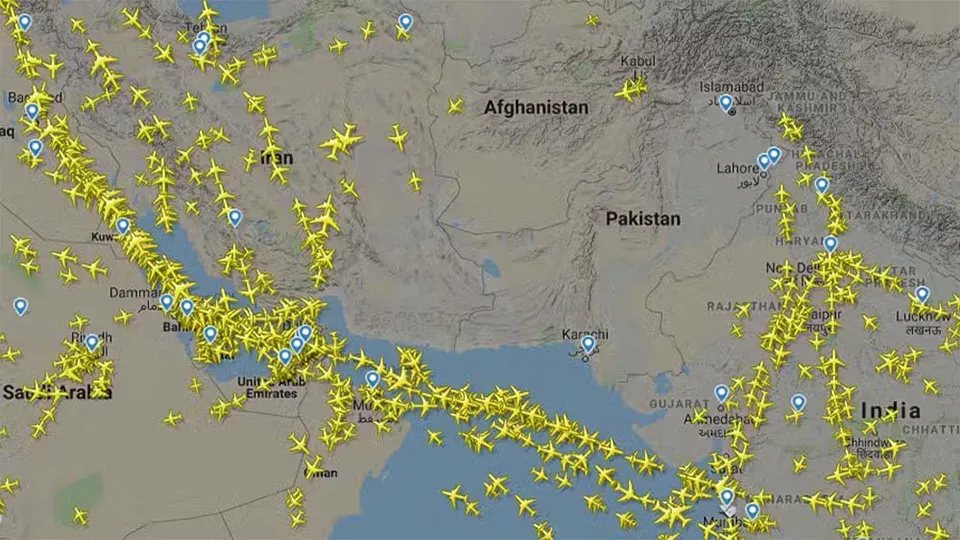The recent Pakistan airspace closure to Indian airlines has sent ripples through the aviation industry, prompting crucial adjustments to many flight routes. Major carriers, including Air India, IndiGo, and SpiceJet, are now required to navigate longer paths to reach Europe, North America, and the Middle East, which invariably escalates operational costs. While these modifications may churn up flight schedules and lead to potential airfare changes, industry analysts predict that the overall increase in ticket prices won’t be as significant as one might expect. The closure is tied to ongoing tensions surrounding the Kashmir issue, emphasizing the geopolitical factors impacting travel dynamics in the region. As the situation develops, understanding the implications of this airspace closure will be essential for travelers and airline operators alike, especially amidst fluctuating travel demand and price sensitivity.
The recent decision by Pakistan to restrict air traffic for Indian carriers marks a notable shift in regional aviation protocols, elaborating the complex interplay between aviation logistics and geopolitical tensions. Affected airlines, such as Air India and IndiGo, are now faced with the challenge of adapting their flight plans to circumvent Pakistani airspace, resulting in prolonged travel times and increased operational demands. This move inevitably brings about changes in airfare and scheduling, which could affect passenger decisions in a market already sensitive to price fluctuations. The ongoing unrest related to the Kashmir dispute continues to shadow these developments, reminding us that travel routes are not just about logistics, but are heavily influenced by international relations. As the situation evolves, the ripple effects on global air travel and regional connectivity are worth monitoring closely.
Impact of Pakistan Airspace Closure on Indian Airlines
The recent announcement by Pakistan closing its airspace to Indian airlines has sparked significant operational changes for major carriers such as Air India and IndiGo. These airlines are now compelled to reroute their flights towards destinations in Europe, North America, Central Asia, and the Middle East, which can extend flight duration and increase operational costs. This redirection not only leads to longer travel times but may also necessitate additional refueling stops, fundamentally altering the dynamics of flight scheduling and efficiency. As airlines scramble to adjust, the implications for passenger experience and operational efficiency continue to unfold.
Despite these challenges, many aviation analysts anticipate that airfare changes will not reflect the spike in operational costs Indian airlines are likely to encounter. Historical patterns, such as those observed following previous airspace closures, show that airlines may absorb some of these costs rather than passing them on to consumers. While ticket prices may fluctuate, significant fare increases across multiple routes are not anticipated, particularly as competition among airlines continues to intensify. The current environment highlights both the resilience and adaptability of carriers facing geopolitical challenges.
Rerouting Flight Paths and Its Consequences
With the closure of Pakistan’s airspace, Indian airlines are forced to reconsider their flight paths, a situation reminiscent of operational adjustments made during previous restrictions. Major destinations such as Almaty and Tashkent saw immediate route suspensions, while airlines like IndiGo communicate potential disruptions to their vast international traffic. As the airlines work to modify their routes, passengers may experience unexpected delays or cancellations, adding another layer of complexity to travel plans. It remains crucial for travelers to stay informed and proactive about their itineraries, especially as adjustments are made in real-time.
Moreover, the longer flight routes raise questions about safety and efficiency. As Asian airlines navigate through this airspace congestion, an increased risk of operational challenges can occur. With additional refueling stops, the overall carbon footprint of these journeys may also rise, which could attract scrutiny from environmental advocates. Balancing operational costs with customer expectations during this intricate time period emphasizes the need for effective communication from airlines to mitigate customer dissatisfaction and maintain confidence in air travel.
Potential Ripple Effects on Airfare and Competition
Economists predict that while operational costs for Indian airlines will soar due to rerouted flights, a substantial increase in airfares may not occur. Past closures of Pakistani airspace, such as the situation in 2019, illustrated that while airlines suffered financially, they showed an ability to stabilize ticket prices in response to competitive dynamics. This trend suggests that existing market competition and airline strategies might absorb the disruptions without significantly inconveniencing passengers financially. As an airline like Air India navigates these operational hurdles, it must maintain a transparent approach to pricing strategy to retain passenger trust.
Moreover, the competitive landscape within the South Asian aviation market holds the potential for strategic shifts. Indian carriers now find themselves under increased pressure to enhance service offerings and adjust pricing structures to remain appealing against alternative airlines that are unaffected by the closure of Pakistani airspace. Travel fluctuations and unique regional dynamics, particularly surrounding routes affected by geopolitical conditions, illustrate the need for airlines to innovate and adapt swiftly in a challenging environment to capture market share.
Kashmir Issue’s Influence on Airline Operations
The backdrop of the Kashmir issue continues to loom large over the operational capabilities of Indian airlines, especially in light of recent events. With heightened tensions manifesting in travel restrictions, connectivity between key cities remains at stake, exacerbating the challenges faced by Indian airlines. The ongoing diplomatic efforts to address the Kashmir conflict underscore the complexity surrounding aviation operations in the region. Travelers may find that political climates could inadvertently disrupt their travel plans, making it essential for airlines to keep updated communication channels open throughout this tumultuous period.
As airlines navigate these political sensitivities, they also bear the responsibility of safeguarding their operational integrity while ensuring passenger safety and satisfaction. The Kashmir issue has historically had ripple effects on tourism and travel preferences, impacting flight schedules to a region that has become increasingly attractive for both domestic and international travelers. It is imperative now, more than ever, for airlines to recalibrate their strategic approach, combining robust risk assessment with a proactive customer service ethic to weather the storm imposed by both political factors and operational challenges.
Adaptability of Indian Airlines in a Changing Scenario
As Indian airlines grapple with the fallout from Pakistan’s airspace closure, their adaptability is being put to the test. Airlines such as SpiceJet and Akasa Air are re-evaluating their operational strategies—redesigning routes while striving to maintain profitability amid heightened operational costs associated with longer flying distances. The capacity of these carriers to respond swiftly and effectively to shifting conditions will likely determine their competitive edge, particularly against international carriers that are less affected by similar geopolitical issues. Enhanced adaptability could lead to novel service options or promotional fares, aimed at offsetting the negative impacts of rerouted flights.
Additionally, the response of airlines to customer needs during this period will be crucial. With a rise in operational costs due to enforced rerouting, the potential for enhanced customer service initiatives may present an opportunity for airlines to distinguish themselves from competitors. The facilitation of refunds and flexible rescheduling can lead to increased customer loyalty, setting a trend that can help offset potential fare drops and bolster the airlines’ reputation. As the landscape shifts, it is evident that an airline’s success will hinge on its ability to identify opportunities within adversity.
Customer Service Challenges and Innovations
The recent airspace closure highlights the pivotal role of customer service for affected airlines. As travel schedules become disrupted, airlines such as Air India and IndiGo are proactively addressing passenger concerns by facilitating refunds and offering alternate travel options. This gesture is not just a temporary fix; it signifies a commitment to customer satisfaction during challenging scenarios. Each airline’s approach to resolving these issues will impact not only their reputation but also the overall perception of air travel in the region, especially among frequent flyers who prioritize reliable service.
In response to emergent challenges, airlines are also embracing innovations that can enhance the customer experience. With the integration of digital technology, airlines can streamline communication about flight changes, provide real-time updates, and facilitate easier navigation of travel changes for their passengers. Implementing intuitive digital platforms will allow for better service delivery and customer engagement amidst the turbulence of operational changes, ensuring that airlines maintain a competitive edge by focusing on building long-term relationships with their clients.
Future of Air Travel in the Indian Subcontinent
Looking ahead, the future of air travel in the Indian subcontinent is poised for transformation as geopolitical tensions continue to shape operational dynamics. The closure of airspace to Indian airlines exemplifies the critical intersection of politics and aviation, where shifts in policy can have profound ramifications for travel routes and prices. Significantly, the industry’s ability to adapt to these fluctuating circumstances will be a definitive factor in its growth. Airlines might explore alternative partnerships, optimizing alliances to remain competitive and relevant in an era of significant operational reconfiguration.
Moreover, as airlines navigate through these challenges, the growing emphasis on sustainability may further modify operational strategies. The need to balance increased operational costs with environmentally-friendly practices might push carriers to innovate in terms of route planning and fleet technologies. The evolving landscape of air travel will likely see a re-emergence of focus on retaining passenger trust while efficiently addressing the complex demands placed by political and operational factors, ultimately contributing to a more resilient aviation sector in the South Asian region.
Economic Implications of Operational Changes
The economic implications stemming from the operational changes due to the Pakistan airspace closure are multifaceted. On one hand, Indian airlines face mounting operational costs associated with increased fuel consumption and longer flight durations. On the other, these changes might deter potential passengers due to uncertainty surrounding flight schedules and fare hikes that could emerge. However, historical trends suggest that airlines will strive to minimize fare increases to retain customer loyalty, thereby potentially stifling the financial repercussions of this operational upheaval.
As airlines seek to balance cost management with passenger accessibility, creative pricing strategies may emerge that cater to varying consumer preferences. This could involve flexible pricing models or bundled service offerings that provide enhanced value and boost competitiveness in a strained market landscape. The ability of airlines to navigate these precarious economic waters will be crucial for sustaining operational viability and ensuring continued patronage from both business and leisure travelers alike.
Frequently Asked Questions
What impact does Pakistan’s airspace closure to Indian airlines have on flight routes?
Pakistan’s airspace closure to Indian airlines requires carriers like Air India, IndiGo, and SpiceJet to modify their flight routes, resulting in longer travel times and potential operational challenges. This disruption affects connections to Europe, North America, Central Asia, and the Middle East, as carriers navigate around the restricted airspace.
How does the closure of Pakistan’s airspace to Indian airlines influence operational costs?
The closure of Pakistan’s airspace to Indian airlines is likely to increase operational costs due to longer flight paths and additional refueling stops. Airlines must adjust their flight schedules and routes to comply with airspace restrictions, a change that could strain their resources and budgets.
Will airfare change significantly due to Pakistan’s airspace closure affecting Indian airlines?
Despite the increased operational costs for Indian airlines from Pakistan’s airspace closure, aviation analysts suggest that airfare may not rise significantly across the board. Historical trends indicate that airlines can absorb certain costs without directly passing them on to consumers immediately.
What are the potential effects of Pakistan’s airspace closure on Indian airlines’ flight schedules?
The closure of Pakistan’s airspace to Indian airlines could result in significant changes to flight schedules, leading to longer wait times, additional refueling stops, or even cancellations. Airlines may have to restructure their operations to manage these impacts effectively.
How does the Kashmir issue relate to the closure of Pakistan’s airspace to Indian airlines?
The closure of Pakistan’s airspace to Indian airlines occurs against the backdrop of ongoing tensions related to the Kashmir issue. This geopolitical conflict contributes to the restrictions, influencing not only flight operations but also the overall travel dynamics between India and Pakistan.
Which Indian airlines are affected by the closure of Pakistan’s airspace, and how are they responding?
Major Indian airlines, including Air India, IndiGo, and SpiceJet, are directly affected by the closure of Pakistan’s airspace. In response, these airlines are rerouting flights, offering refunds, and rescheduling for impacted passengers, demonstrating a commitment to customer service amid operational disruptions.
What historical precedent exists for airfare changes following airspace closures like that of Pakistan’s?
Historically, closures of airspace, such as the one in 2019, have resulted in operational losses for airlines, yet significant fare increases were not observed. This suggests that while costs may rise due to restrictions like Pakistan’s airspace closure, fare hikes may not be immediate or drastic.
How might passengers be affected by the rerouting of flights due to Pakistan’s airspace closure?
Passengers may experience longer travel times, changed flight schedules, and possible cancellations as Indian airlines adjust routes due to the closure of Pakistan’s airspace. This could lead to additional refueling stops or logistical challenges for travelers.
What routes are likely to be impacted by Pakistan’s airspace restrictions for Indian airlines?
Approximately 50 routes are expected to be affected by the closure of Pakistan’s airspace to Indian airlines, including significant international connections to North America and Europe, as well as flights to nearby cities like Almaty and Tashkent that have already been temporarily suspended.
How does the closure of Pakistan’s airspace compare to previous airspace restrictions experienced by airlines?
The closure of Pakistan’s airspace shares similarities with past restrictions, such as that imposed by Russia, which compelled European airlines to reconsider their operational strategies due to increased operational costs from longer routes. This showcases the broader implications of airspace limitations on international travel.
| Key Points | Details |
|---|---|
| Airspace Closure | Pakistan has closed its airspace to Indian airlines, necessitating route adjustments. |
| Affected Airlines | Major airlines impacted include Air India, IndiGo, and SpiceJet. |
| Operational Costs | Flights may require longer routes and additional refueling stops, leading to increased costs. |
| Impact on Airfares | Analysts suggest that airfares may not see significant increases despite operational challenges. |
| Number of Affected Routes | Speculation indicates that about 50 routes could be affected, with some flights to Almaty and Tashkent suspended. |
| Past Trends | Historically, previous airspace closures have not resulted in major fare hikes. |
| Refunds and Rescheduling | Airlines like Air India and IndiGo are offering refunds and rescheduling for affected passengers. |
Summary
Pakistan airspace closure has introduced significant implications for Indian airlines, necessitating adjustments that could increase operational costs. However, analysts remain optimistic that these changes may not translate into higher airfares for passengers. Airlines face longer routes and potential service disruptions, but strategic decisions such as offering refunds and rescheduling suggest a commitment to customer service during this tense period. As the situation develops, the impact on travel patterns to and from the region, especially concerning tourism in Kashmir, remains to be fully realized.



